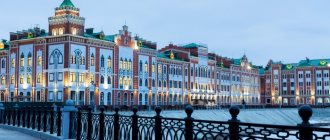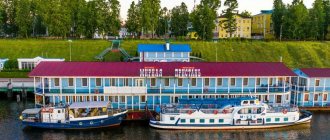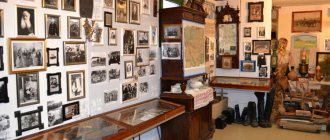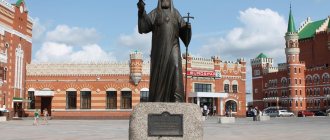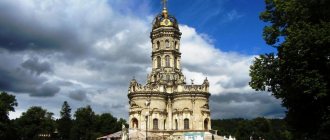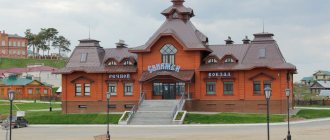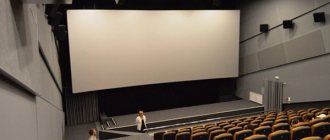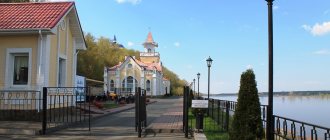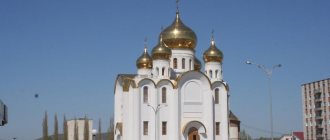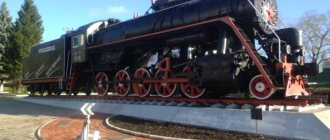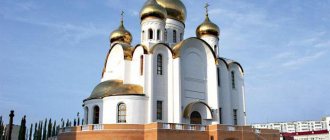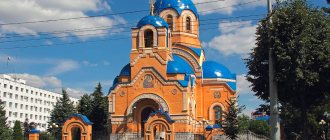Have you been to Yoshkar-Ola? Yoshkar-Ola is the capital of the Mari El Republic, located in the Volga region, 860 km from Moscow. This city is not very well explored by tourists. Basically, tours are organized there from nearby cities, or as an addition to a tour to Kazan. In my opinion, this is not entirely deserved. There is a lot to see in Yoshkar-Ola, and although its main attractions were created already in this century, tourists visiting the city will receive not only great pleasure, but also magnificent photos as a souvenir.
History of Yoshkar-Ola
The city was founded in 1584 on the Malaya Kokshaga River and until 1919 had the difficult to pronounce name Tsarevokokshaisk (royal city on Kokshaga). Before the 1917 revolution, the town included only 13 streets and had no industry. In 1919 it was renamed Krasnokokshaysk, and in 1928 it received the name Yoshkar-Ola, which translated from the Mari language means “Red City”. Then Yoshkar-Ola first received the status of the administrative center of the Mari Autonomous Region, since 1936 it became the capital of the Mari Autonomous Soviet Socialist Republic, and is currently the capital of the Mari El Republic.
Classes
Sights of Yoshkar-Ola
The main occupation is arable farming. The soil was cultivated with a plow (shogavuy), a plow (agavuy, saban), a harrow (tyrma, shure), and a hoe (katman).
The main field crops are rye, oats, barley, millet, spelled, buckwheat, potatoes; technical – hemp, flax, hops; vegetables - onions, cabbage, radishes, carrots.
Among the mountain Mari in the 19th century. Gardening developed.
The Mari bred horses, cattle, sheep, and poultry; Almost no pigs and goats were kept, considering them “unclean” and unsuitable for sacrifice.
Hunting, fishing, beekeeping (later apiary beekeeping), and gathering were of secondary importance.
Crafts associated with the processing of wood, plant fiber, wool, leather (charcoal burning, tar smoking, weaving, wickerwork, etc.) retained their importance in the household, but during the development of capitalist relations their products acquired commercial value. Developed artistic crafts include: jewelry (making silver women's jewelry), wood carving, weaving, and embroidery.
How to get there
Getting here from Moscow is quite difficult and inconvenient since the Yoshkar-Ola airport ceased operations on December 31, 2015. A train runs from Moscow and back once a day. The railway is single track and non-electrified. You can fly to Kazan by plane, but from there you will again have to travel by bus or train (trains do not run every day), the distance is about 200 km. Train schedules can be found HERE.
Origin of the Mari people
Yoshkar-ola - Russia
The ancient homeland of the Mari stretched along the banks of the Volga, which divided the people into two ethnic groups with differing traditions, language and costumes - the mountain and meadow Mari.
The history of the Mari lands contains many interesting lines: it passed into the possession of the Golden Horde, and later the Kazan Khanate.
At this time, the new government not only introduced serfdom, military conscription and exorbitant taxes on their territory, but also forcibly baptized the pagan Mari. For 30 years, the Mari people rebelled and resisted.
We know this historical period under the name Cheremis Wars. Many Mari left their ancient homeland, going to Tatarstan, the Perm region and Bashkortostan, and became known as the Eastern Mari.
Over time, the new culture and Orthodox faith took root among the Mari and began to replace their previous beliefs. Some of the population, like the Tatars, converted to Islam.
But none of these religions could completely replace and supplant paganism. The cult of spirits, numerous deities and the animation of nature continued.
Description of the sights of Yoshkar-Ola
The city has preserved a number of ancient buildings from the 18th and 19th centuries, but the main attractions that attract tourists were built after 2007.
The area named after Obolensky-Nogotkov
This first square, equipped according to the new project, opened in 2007, is located opposite the city hall. And, by the way, very close to the Ludovico Moro hotel. The buildings of the square ensemble are built in the Venetian style and include a shopping center, an art gallery, and administrative buildings. In front of them there are two monuments - to Prince Obolensky-Nogotkov, the first governor of the city, and to the Holy Martyr Leonid. There is also a life-size replica of the Tsar Cannon. But the main attraction of the square is the clock on the facade of the art gallery building.
Every hour, to the music of Rachmaninov, a donkey appears and moves in a circle with the icon of the Virgin Mary. The spectacle is very beautiful.
Square of the Republic and the Blessed Virgin Mary
Walking further towards the city center, you will soon find yourself in front of the Malaya Kokshaga River embankment. The river itself is small, but in the city center it widens and looks like a lake. In the center of the square there is the Annunciation Tower - a smaller copy of the Spasskaya Tower of the Moscow Kremlin - and a fountain. The tower was built in 2011. Construction of the Cathedral of the Annunciation of the Blessed Virgin Mary is underway nearby.
Bruges waterfront
After crossing the bridge, you will find yourself on the embankment, which is popularly called Bruges due to its resemblance to this picturesque Belgian city. This may be its official name, but I'm not sure. The embankment is lined with very beautiful buildings in the medieval style.
Patriarchal Square
There is a building with another famous clock on it. Every 3 hours from 9 to 21 o'clock the figures of Jesus and the twelve apostles come out to music. The twelfth of them - Judas Iscariot - walks behind everyone, with his head bowed, carrying a bag with thirty pieces of silver. Also on the square is a monument-fountain to Peter and Fevronier on a boat, a monument to Patriarch Alexy II.
Monuments in Yoshkar-Ola
There are a huge number of monuments in Yoshkar-Ola (more than 50), some remain from Soviet times, but most of them are new. Most modern monuments are made of bronze. I have already listed some. On Voskresenskaya Embankment there is an unusual monument to Pushkin and Onegin: the poet. sitting casually on a bench, communicating with his hero.
There are other unusual monuments. For example, the bench of Love and Fidelity is used to reconcile lovers, because its surface slopes towards the middle, and those who sit on it inevitably end up next to each other. The funniest ones are the monument to Yoshkin’s cat and Yoshkin’s cat.
By the way, “Yoshkin Kot” is also a brand of local vodka, which is often bought as souvenirs. With all the monuments you can take great photos as a souvenir.
Mari culture
All entertainments in Yoshkar-Ola
The Mari people are also unique in the preservation of many ancient rituals, including wedding and funeral ones. But we will dwell in more detail on a particularly original ritual of expelling an evil spirit from the village - Surem Uzho.
This ritual is performed on the outskirts of the village on the night of May 6th. The date was not chosen by chance - the purpose of the action is to protect the village from evil during the grazing season.
Participants in the ritual jump over the fire as an act of self-purification, and then go to the village, where they visit all the houses with noise and ringing of bells. The household, in turn, treats the guests to bread, potatoes and eggs.
When the tour of houses comes to an end, the ritual participants relight the fire and cook food in pots. It is customary to bury some of the delicacy, as if bringing gifts to the earth, and eat the rest. The ritual lasts until the morning.
The Mari culture is rich not only in rituals, but also in dances. One of the surviving ancient dances is kandyra, or “Rope”. Most often it is performed by two young men and one girl, but often several couples participate in the dance, forming a chain of dancers.
The main movement is a shot, that is, a quick movement of the legs in place. The dance rhythm is set by Mari ritual instruments - the drum and the shuvyr (a kind of bagpipe). Many movements are given the meaning of self-purification.
Traditional Mari costume
Speaking about culture, we cannot fail to mention the traditional Mari costume. The fabric for the national dress is usually created from woolen threads spun at home.
This fabric is called motley because of the multi-colored threads. Then the Mari craftswomen embroider the costumes with ancient patterns: birds, horses, solar signs, ram's horns, plants.
The symbolism of this ornament signifies fertility and renewal. The girls made jewelry from coins and beads. Craftswomen believed that such products protected them, and the ringing of silver scared away evil forces.
What else to visit
There are several theaters in the city, quite good, as they say, but I didn’t get into them.
If you are traveling with children, be sure to visit the puppet theater.
There are also several museums in the city - the Museum of the History of the City of Yoshkar-Ola, the Museum of Fine Arts, the Museum of the Republic of Mari El, the Gulag Museum and others. The Central Park of Culture and Recreation is very beautiful; it also has many monuments, fountains, and playgrounds. In general, the city is very cozy and green, there are many squares and parks. In 2012, the Italian Park opened, the main decoration of which is the alley of Canadian red maples.
For lovers of active recreation - in a city with a population of 250 thousand people there are two ice palaces that operate year-round - the capital, after all.
In Yoshkar-Ola in the summer you can see a lot of cyclists. In numerous squares, children enjoy rollerblading and hoverboarding. Come to Yoshkar-Ola, you won’t regret it!
Popular message topics
- Stars
Looking at the cloudless sky at night, you can see an incredible picture of the starry sky. More than a thousand stars gather in various shapes, making everyone enjoy the beautiful views. A long time ago, many believed that the sky is not decorated with stars, - The Caucasus in the life and work of Lermontov
The Caucasus occupies a very important place in the works of Russian writers of the 19th and 20th centuries. Many writers decided to leave big cities (sometimes of their own free will, sometimes not), change their surroundings and look for inspiration in the Caucasus. And we can say - Muscles
What are muscles? This is the most active part of our motor system, thanks to which we can perform various actions: walk, jump, swim, and so on. But these processes are not only external,
Traditions
The ancient traditions are most fully preserved in wedding and funeral rites. The wedding always began with a noisy ransom, after which the newlyweds, on a cart or sleigh covered with bear skin, headed to the cart for the wedding ceremony. All the way, the groom cracked a special whip, driving away evil spirits from his future wife: this whip then remained in the family for life. In addition, their hands were tied with a towel, which symbolized the connection for the rest of their lives. The tradition of baking pancakes for the newly-made husband on the morning after the wedding has also been preserved.
Funeral rites are of particular interest. At any time of the year, the deceased was taken to the churchyard on a sleigh, and put into the house in winter clothes, supplied with a set of things. Among them:
- a linen towel along which he will descend to the kingdom of the dead - this is where the expression “good riddance” comes from;
- rosehip branches to ward off dogs and snakes guarding the afterlife;
- nails accumulated during life in order to cling to rocks and mountains along the way;
Forty days later, an equally terrible custom was performed: a friend of the deceased dressed in his clothes and sat down with the relatives of the deceased at the same table. They took him for dead and asked him questions about life in the next world, conveyed greetings, and told him news. During the general holidays of remembrance, the deceased were also remembered: a separate table was set for them, on which the hostess put little by little all the treats that she had prepared for the living.
Family life
After the wedding, the bride went to live in her husband’s house, so the Maries had large families. Families of brothers often coexisted in them; older and subsequent generations, the number of which reached 3-4, lived together. The head of the household was the eldest woman, the wife of the head of the family. She gave children, grandchildren and daughters-in-law tasks around the house and looked after their material well-being. Children in the family were considered the highest happiness, a manifestation of the blessing of the Great God, so they gave birth a lot and often. Mothers and the older generation were involved in upbringing: children were not spoiled and were taught to work from childhood, but they were never offended. Divorce was considered a shame, and permission for it had to be asked from the chief minister of the faith. Couples who expressed such a desire were tied back to back in the main village square while they awaited a decision. If a divorce occurred at the request of a woman, her hair was cut off as a sign that she was no longer married.
Religion
Religion has played a special role in the life of the Mari people in all centuries. The traditional Mari religion has still been preserved and is officially registered. It is professed by about 6% of the Mari, but many people observe the rituals. The people have always been tolerant of other religions, which is why even now the national religion coexists with Orthodoxy. The traditional Mari religion proclaims faith in the forces of nature, in the unity of all people and everything on earth. Here they believe in a single cosmic god, Osh Kugu-Yumo, or the Great White God. According to legend, he instructed the evil spirit Yin to remove from the World Ocean a piece of clay from which Kugu-Yumo made the earth. Yin threw his part of the clay onto the ground: this is how the mountains turned out. Kugu-Yumo created man from the same material, and brought his soul to him from heaven.
In total, there are about 140 gods and spirits in the pantheon, but only a few are especially revered:
- Ilysh-Shochyn-Ava - analogue of the Mother of God, goddess of birth
- Mer Yumo - manages all worldly affairs
- Mlande Ava - goddess of the earth
- Purysho - god of fate
- Azyren - death itself
Mass ritual prayers take place several times a year in sacred groves: there are between 300 and 400 of them throughout the country. At the same time, services to one or several gods can take place in the grove, sacrifices are made to each of them in the form of food, money, and animal parts. The altar is made in the form of a flooring of fir branches, installed near the sacred tree.
Those who come to the grove prepare the food they brought with them in large cauldrons: meat of geese and ducks, as well as special pies made from the blood of birds and cereals. Afterwards, under the guidance of a card - an analogue of a shaman or priest, a prayer begins, which lasts up to an hour. The ritual ends with eating what has been prepared and cleaning the grove.
